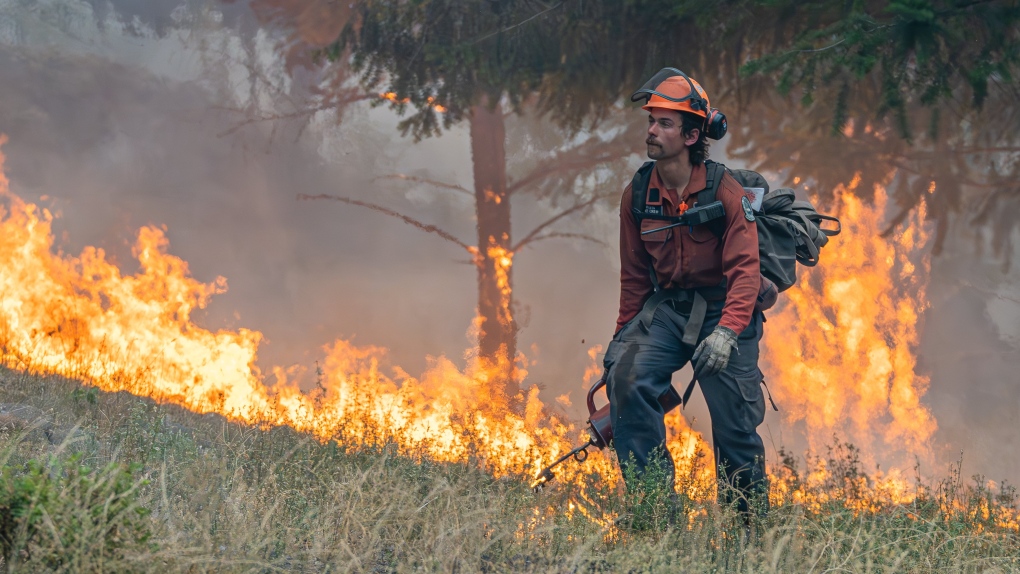B.C. officials warn of abnormal fall as warm, dry conditions keep wildfire risk high
 A firefighter performs small hand ignitions on the 2023 McDougall Creek wildfire near West Kelowna. (Image credit: BC Wildfire Service)
A firefighter performs small hand ignitions on the 2023 McDougall Creek wildfire near West Kelowna. (Image credit: BC Wildfire Service)
Looking ahead into the fall, B.C. officials are warning of an abnormal season to come as warm, dry conditions are expected to continue.
The province-wide state of emergency put in place due to the wildfire situation is set to expire at midnight on Sept. 15 unless officials decide to extend it, which they will deliberate over the next 24 hours, said Bowinn Ma, B.C.'s minister of emergency management and climate readiness, at a news conference Wednesday.
“We are nearing the end of the fire season, but we are not yet in the clear,” Ma reiterated.
She noted that hundreds of wildfires continue to burn across the province, with a particularly concerning situation in the north, where above-seasonal temperatures and winds are expected to pose a challenge to the wildfire fight this week.
Ma said there are currently 1,200 British Columbians still on evacuation order, with another 34,000 on evacuation alert.
There are 393 active wildfires in the province, and 12 of them are “of note,” meaning they are highly visible or pose a threat to public safety, said Minister of Forests Bruce Ralston.
That’s more than double the number of fires that was burning this time last year, when there were 188 active blazes and five fires of note, he said.
”It has been a long, challenging fire season, the worst in British Columbia's history, and it is not over yet,” said Ralston.
Heading into fall, officials said a “very atypical” season is in store in the north.
Neal McLoughlin, superintendent of predictive services for BC Wildfire Service said the Buildup Index (BUI), which measures the total amount of fuel readily available to burn, is at a “very pronounced above-normal anomaly throughout northern B.C.”
He added that forecasts predict both warmer and drier conditions than normal across B.C. through September, October and November. And as the leaves change colour, “live vegetation will become more available to burn and easier to ignite,” McLoughlin said.
With fuel remaining “critically dry” and not enough rain to help out, he said the fires burning in the Prince George Fire Centre will continue burning through the fall, and some may even burn through the winter and pop back up next spring.
McLoughlin said patterns of cold fronts and winds will continue coming in without precipitation.
“When we have these weather patterns set up, things can quickly escalate and so fires that haven't been doing anything for several days could quickly go to run 10, 20, even more kilometers in one single day,” he explained.
“These will be short lived wildfire events, but they can be high-impact depending on where they occur. So just a reminder that we're not out of the fire season yet and drawing particular attention to the far north.”
The good news is that lightning-caused fires—which accounted for 72 per cent of starts this year—are expected to decline in the coming months, he said.
Any new fires this fall will likely be human-caused.
“We really do encourage the public to be careful with any kind of activity that could cause a fire,” McLoughlin said.
CTVNews.ca Top Stories

Canada could impose tariffs on U.S. steel, orange juice in response to Trump threat
Canadian officials are narrowing a list of American products to target in the event the federal government must respond to U.S. tariffs on Canadian goods, CTV News has confirmed.
Convicted Jan. 6 rioter arrested as fugitive in Whistler, B.C.
An American citizen convicted of participating in the Jan. 6, 2021, riot on Capitol Hill who said he was seeking asylum in Canada has been arrested as a "fugitive from U.S. justice," according to authorities.
Can the U.S. really make Canada the 51st state?
Talk of Canada becoming the 51st American state has raised an existential question on this side of the border: Could it be done? Could the maple leaf make way to the stars and stripes? According to several experts, it may be possible, but not painless.
L.A. wildfires continue to devastate area, Canada prepared to offer expertise
A series of wildfires are searing through the Los Angeles area, forcing many to evacuate their homes. Here's everything that happened throughout Jan. 8.
'True when I said it, true today': former Canadian PM Harper pushes back against Trump on social media
Former Canadian Prime Minister Stephen Harper doesn’t find president-elect Donald Trump’s jibes about Canada becoming the 51st U.S. state very amusing.
Ontario Premier Doug Ford says he is 'OK' after OPP vehicle he was in was 'sideswiped' in Highway 401 collision
Ontario Premier Doug Ford was uninjured after an OPP vehicle he was travelling in was involved in a collision on Highway 401 earlier today.
At least 60 University of Guelph students sick as 'cluster of illness' hits residence
The University of Guelph is dealing with what they are calling a ‘cluster of illness’ among students living in residence.
Energy minister 'committed' to consumer carbon tax as he considers Liberal leadership
Energy and Natural Resources Minister Jonathan Wilkinson says he would be 'committed' to the consumer carbon tax should he become Liberal leader and prime minister, despite the policy’s unpopularity.
New ranking suggests Canada passport among 'top 5 losers' in the world
A new global ranking may raise doubts about Canada's reputation of being open to other countries.
































